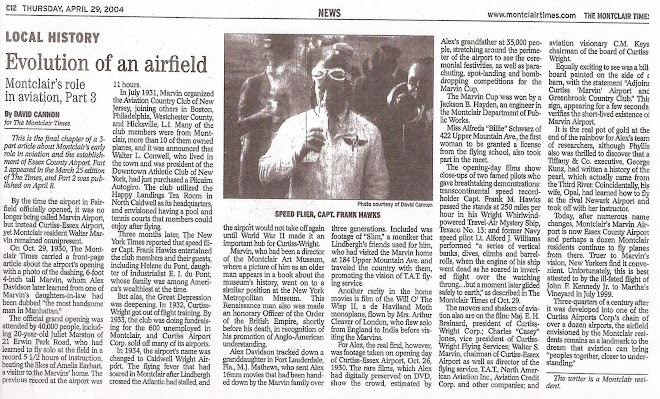Curtiss Airports Corporation
Walter Marvin resided at 184 Upper Mountain Avenue, attended First Congregational Church, and was a former trustee of the Montclair Art Museum, a vice president of the Montclair Theater Guild, a member of the Montclair Golf Club, and on the budget committee of the Community Chest, according to a October 18, 1930 "Who's Who in Montclair" profile in The Montclair Times.
A poet and newspaper reporter as a young man, Marvin told the Times that the "'arts of communications and transportation are the greatest civilizing influences…removing fears from human life...(bringing) the remotest peoples together, closer to understanding.'" The profile also noted that his Brooklyn-born wife, Jean Murray Marvin, had been the first adult woman to make a transcontinental air trip, when she was a pioneering passenger journeying over T.A.T's "Lindbergh Air-Rail Line” from New York to Los Angeles and San Francisco.
All other Essex Airport, Inc. executives were also from Montclair: George F. Hewitt Jr.; William Osgood Morgan; Adolph J. Lins, president of the Montclair Trust Company, and Herbert E. Jefferson.
Marvin, Hewitt and Lins were also on the airport's board of directors which included: Ralph H. Bollard, member of Dillon, Reade & Company; William O. Morgan, attorney with Noble, Morgan and Scammell; Jansen Noyes of Hemphill, Noyes and Company; Roy E. Tomlinson, president of National Biscuit Company (later Nabisco); and James C. Willson, a pioneer of aviation organization and financing involved in a dozen such companies and president of National Aviation Corporation. Robert Christie and William L. Maude were to undertake the development of the airport and were instrumental in directing the $500,000 plus acquisition of the airport. Christie also was the first president of the Essex Flyers’ Club, which was chaired by Montclair’s director of the Department of Public Works, Commissioner Arthur P. Heyer, who had recommended a municipally controlled airport for Montclair in December 1928.
Both Marvin and Willson were directors of Transcontinental Air Transport Company (T.A.T. was predecessor of TWA), which at the time was in a joint partnership with the Pennsylvania Railroad to provide 48-hour air-rail service to the West Coast. The airport would also serve cross-country flyers and mail planes coming from the west whose pilots did not want to deal with the fog and smoke over the Newark meadows and Long Island.
Adjacent to the airport was the soon-to-be-constructed Passaic Avenue, a significant western part of the so-called "Metropolitan Loop Highway." Plans for this road system in the early 1930s called for it to run around New York City, crossing over the newly constructed George Washington Bridge, out Route 4 to the Fair Lawn area then looping southwest to Passaic Avenue which would eventually run over to Livingston past another airport and down to Newark. Marvin and Willson saw the Loop as a way to speed airplane passengers down to Penn Station in Newark for rapid transit into New York City.
Those two Montclair men were also directors of Curtiss Flying Service, Inc. and within a month the new airport was taken over as a wholly owned subsidiary of the newly formed Curtiss Airports Corporation, headed by C. M. Keys (on the right), a man later regarded as "The Father of American Commercial Aviation."
In 1930 Keys-Hoyt held over two dozen aviation-related companies, and years later, he also developed Peruvian International Airways and China National Aviation Corporation, which played a role in the development of the Flying Tigers American Volunteer Group prior to America’s entry into the Asian arena in World War II. Among other Curtiss Airports Corporation directors were Erle P. Halliburton founder of the company that Vice President of the United States Richard Cheney eventually presided over, and Donald Douglas who would revolutionize flight with the DC-3.
Following the takeover of the new airport facility in Fairfield, it was still to be known as Marvin Airport and to be presided over by Montclair resident Walter Marvin. At the same time, Curtiss Airports issued stock and raised over $31 million to acquire at cost thirteen fields across the country that would be used for private planes and training flyers.
It was envisioned that some 400 student flyers would train under the direction of Charles S. ("Casey") Jones, a former football coach at Montclair Academy. The Montclair Times on May 11, 1930 described Jones as a "world famous flier and former resident of Montclair." The airport's location was considered a perfect place to train because "open meadows on every side, and nearby golf courses afford many emergency landing places."
In July, 1929, the newspaper reported that Colonel Charles Lindbergh was considering purchasing a home on a North Caldwell mountain overlooking the airport, but the deal fell through, and he made his fateful move to the Hopewell Junction where his son was kidnapped and murdered.
Curtiss Airports Corporation also purchased radio station WRNY dedicating it to aviation information including events at its airports in Valley Stream, Flushing and the Fairfield section of Caldwell Township.
Labels: Aviation, Curtiss-Wright, history
C. M. Keys,
Caldwell,
China National Aviation,
Curtiss Airports,
Metropolitan Loop Highway,
Montclair Art Museum,
National Aviation,
Pennsylvania Railroad,
TAT,
Transcontinental Air,
Walter Marvin
Subscribe to:
Post Comments (Atom)



No comments:
Post a Comment